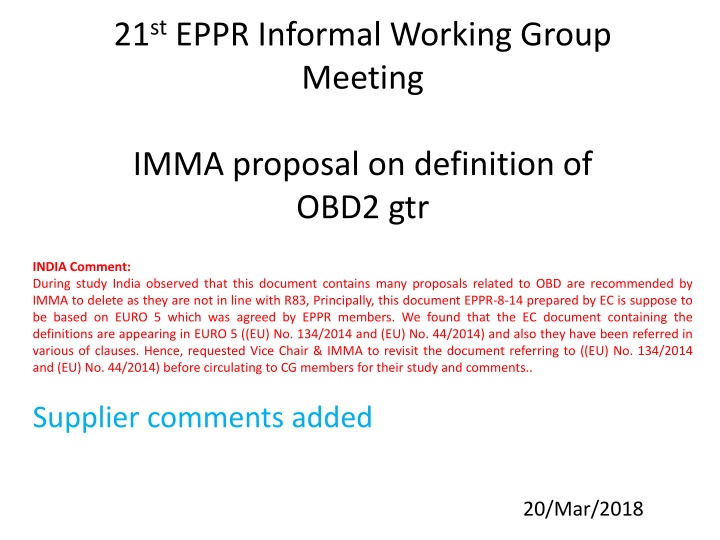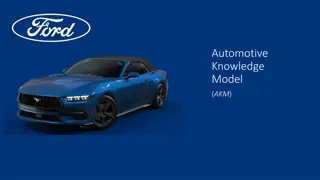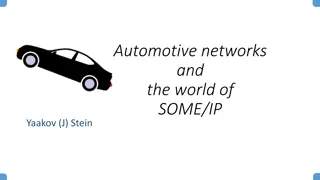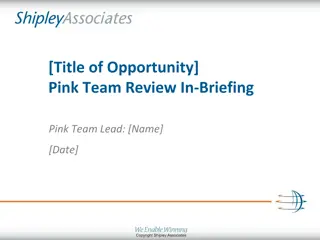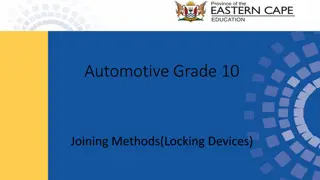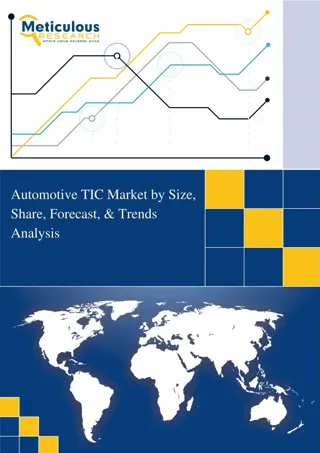Proposal Review on OBD2 Definition in Indian Automotive Sector
As part of the 21st EPPR Informal Working Group Meeting, a proposal on the definition of OBD2 in the Indian automotive industry was discussed. The document highlighted discrepancies between the proposed changes and existing regulations, particularly in relation to EURO 5 standards. There were recommendations to align the document with EU regulations before circulating it for further feedback. Specific points regarding definitions, fault codes, driving cycles, hybrids, and calibration were reviewed for clarity and accordance with relevant standards.
Download Presentation

Please find below an Image/Link to download the presentation.
The content on the website is provided AS IS for your information and personal use only. It may not be sold, licensed, or shared on other websites without obtaining consent from the author.If you encounter any issues during the download, it is possible that the publisher has removed the file from their server.
You are allowed to download the files provided on this website for personal or commercial use, subject to the condition that they are used lawfully. All files are the property of their respective owners.
The content on the website is provided AS IS for your information and personal use only. It may not be sold, licensed, or shared on other websites without obtaining consent from the author.
E N D
Presentation Transcript
21stEPPR Informal Working Group Meeting IMMA proposal on definition of OBD2 gtr INDIA Comment: During study India observed that this document contains many proposals related to OBD are recommended by IMMA to delete as they are not in line with R83, Principally, this document EPPR-8-14 prepared by EC is suppose to be based on EURO 5 which was agreed by EPPR members. We found that the EC document containing the definitions are appearing in EURO 5 ((EU) No. 134/2014 and (EU) No. 44/2014) and also they have been referred in various of clauses. Hence, requested Vice Chair & IMMA to revisit the document referring to ((EU) No. 134/2014 and (EU) No. 44/2014) before circulating to CG members for their study and comments.. Supplier comments added 20/Mar/2018
Cluster of Definitions RMI - - - Fault Codes - DTC - Pending DTC - Confirmed DTC Concept OBD - OBD system - Malfunction - MIL Fault Detection - Driving cycle - Warm up cycle - (Statistics) - (3 dcy in a row) Repair information Standardized data Unrestricted access Hybrids - NOVC & OVC - Driving cycle - Extension Warm up cycle in R83 Emissions and OBD - Decision area - Emission limit (value) - OBD threshold limit (value) - (VIN) - CAL ID - CVN Diagnostic signals: service $1 data stream (incl. readiness) service $2 Freeze Frame service $3 confirmed DTC service $4 erase OBD info service $6 test results, service $7 pending DTC service $9: IUPR, Cal ID, CVN, VIN Technical descriptions - Short & long term fuel trim - Secondary air - Calculated load value Default mode - Default mode - Permanent default mode - Limp home mode
Calibration no opinion Original definition (EPPR-8-14e) IMMA proposal Comment / justification calibration of the powertrain / engine or drive train control unit means the application specific set of data maps and parameters used by the control unit's software to tune the vehicle's powertrain / engine or drive train; Delete this definition 1. Term is too general to be defined. 2. No comparable definition in R83. 3. IMMA propose to delete definition to align with R83. INDIA See general Comment Communication protocol no opinion used in chapter tester communication Original definition (EPPR-8-14e) IMMA proposal Comment / justification communication protocol means a system of digital message formats and rules for exchanging those messages in or between computing systems or units; Delete this definition 1. Term is too general to be defined. 2. No comparable definition in R83. 3. IMMA propose to delete definition to align with R83. INDIA See general Comment Driving cycle see special page Original definition (EPPR-8- 14e) driving cycle means a test type I cycle consisting of engine start-up, driving mode where a malfunction would be detected if present, and engine shut-off; IMMA proposal Comment / justification A "driving cycle" consists of engine key-on, a driving mode where a malfunction would be detected if present, and engine key-off." 1. Definition should be modified to allow hybrid vehicle and to align with R83. INDIA Hybrid is currently out of scope
Driving cycle EU OBD Review for 2wh takes over dcy definitions from R83 EOBD in 3 sections COMMISSION DELEGATED REGULATION (EU) 2018/295 of 15 December 2017 Motivation 4wh: allows hybrids but also start/stop systems , some alignment with CARB 4wh OBD CLEPA: take over at least bold text Delegated Regulation (EU) No 44/2014 is amended as follows: (1) in Article 2, point 42 is replaced by the following: (42) driving cycle means a test cycle consisting of engine key-on, driving mode where a malfunction would be detected if present, and engine key-off; ; 2. Annex XII is amended as follows: (a) the following point 3.2.3.is inserted: 3.2.3. Identification of deterioration or malfunctions may also be done outside a driving cycle (e.g. after engine shutdown). ; (c) the following point 3.10. is inserted: 3.10. Additional provisions for vehicles employing engine shut-off strategies. 3.10.1. Driving cycle 3.10.1.1. Autonomous engine restarts commanded by the engine control system following an engine stall may be considered a new driving cycle or a continuation of the existing driving cycle. ;
NOVC vehicle same as in WLTP GTR 15 Original definition (EPPR-8-14e) NOVC vehicle means a not off- vehicle chargeable hybrid electric vehicle; IMMA proposal Delete this definition Comment / justification 1. No comparable definition in R83. 2. As long as hybrid vehicle is out of scope for this gtr, definition can be deleted. INDIA Hybrid is currently out of scope OVC vehicle same as in WLTP GTR 15 Original definition (EPPR-8-14e) OVC vehicle means an off-vehicle charging hybrid electric vehicle; IMMA proposal Delete this definition Comment / justification 1. No comparable definition in R83. 2. As long as hybrid vehicle is out of scope for this gtr, definition can be deleted. INDIA Hybrid is currently out of scope Software no opinion Original definition (EPPR-8-14e) software of the powertrain / engine or drive train control units means a set of algorithms concerned with the operation of powertrain, engine or drive train data processing systems, containing an ordered sequence of instructions that change the state of the powertrain, engine or drive train control unit; IMMA proposal Delete this definition Comment / justification 1. Term is too general to be defined. 2. No comparable definition in R83. 3. IMMA propose to delete definition to align with R83. 4. Since software is too generic, use of this term in the main test should be replaced by software of power train /engine or drive train of control units . INDIA See general Comment
Repair information part of RMI - tbd Original definition (EPPR-8-14e) D IMMA proposal Delete this definition 1. It is already well described in main text. IMMA proposes to delete definition. Comment / justification INDIA Cooments: 1) IMMA comment that this definition is appearing in the main text is not observed in EPPR-8-14. 2) INDIA proposed to keep this definition and modify the clause in EPPR-8-14 as follows: Clause No. 5.2 in EPPR-8-14 Upon request, the vehicle manufacturer shall make the repair relevant information on the OBD system available to any interested components, diagnostic tool or test equipment manufacturer on a non- discriminatory basis. Alternate proposal based on R83: Clause 3.1.2: Not later than 3 months after the manufacturer has provided any authorized dealer or repair shop with repair information, the manufacturer shall make that information (including all subsequent amendments and supplements) available upon reasonable and non-discriminatory payment and shall notify the type approval authority accordingly. In the event of failure to comply with this provision the type approval authority shall act to ensure that repair information is available in accordance with the procedure laid down for type approval and in-service surveys.
Calibration verification number cluster CAL ID, CVN, VIN see special page Original definition (EPPR-8-14e) IMMA proposal Not defined in original draft. Leave this term undefined. Comment / justification 1. There is definition in GTR No.5, but not defined in OBD1 gtr nor R83. 2. Definition is unnecessary to understand OBD regulation. 3. IMMA propose to leave this term undefined to align with WLTP INDIA Remark: This term is used in EPPR-8-14, it will be appropriate to include in GTR definition. "Calibration verification number" means the number that is calculated and reported by the engine system to validate the calibration / software integrity. Component monitoring - comprehensive components used special page Original definition (EPPR-8-14e) IMMA proposal Not defined in original draft. Leave this term undefined. Comment / justification 1. There is definition in GTR No.5, but not defined in OBD1 gtr nor R83. 2. Definition is unnecessary to understand OBD regulation. 3. IMMA propose to leave this term undefined to align with WLTP INDIA Remark: This term is used in EPPR-8-14, it will be appropriate to include in GTR definition. Engine system no opinion / to be checked Original definition (EPPR-8-14e) Not defined in original draft. IMMA proposal Comment / justification 1. There is definition in GTR No.5, but not defined in OBD1 gtr nor R83. 2. Definition is unnecessary to understand OBD regulation. 3. IMMA propose to leave this term Leave this term undefined.
VIN, CAL ID, CVN Vehicle Identification Number (VIN): unique number to identify a specific vehicle. It is standardized in ISO 3779 (1983) and 3780 (1983). For electronic access it is standardized in SAE J1979 DA. VIN is not required in EOBD 4wh and in OBD for 2/3 wh Software Calibration Identification Number (CAL ID): identifies uniquely software installed in the ECU or other diagnostic or emission related control units of a vehicle. R83/07 for light duty vehicles requires the CAL ID for vehicle type as part of the repair information . The CAL ID is required in the section diagnostic signals , standardized according to SAE J1979 DA. EU 2wheeler Reg. 44/2014 requires the CAL ID in the section diagnostic signals , standardized according to SAE J1979 DA. GTR 5 HDV OBD: "Software calibration identification" means a series of alphanumeric characters that identifies the emission-related calibration / software version(s) installed in the engine system. Calibration Verification Number (CVN): verifies the on-board computer software integrity in diagnostic or emission critical powertrain control units. The CVN shall be capable of being used to determine if the emission- related software and/or calibration data are valid and applicable for that vehicle and CAL ID. The vehicle manufacturer is responsible for determination how many CVN are required and how they are calculated. The EU 2wheeler Reg. 44/2014 requires CVN in the section diagnostic signals , standardized according to SAE J1979 DA. R83/07 for light duty vehicles does not require a CVN. GTR 5 HDV OBD: "Calibration verification number" means the number that is calculated and reported by the engine system to validate the calibration / software integrity.
Decision area when to indicate component as malfunctioning below OTL Original definition (EPPR-8-14e) IMMA proposal decision area means the area between the emission [certification] / [approval] limits and the OBD emission thresholds in which the malfunction indicator may be activated at the choice of the manufacturer; Comment / justification 1. This concept no longer exist in EURO5. 2. If this concept is no longer used in gtr as well, definition is unnecessary. Delete this definition Long-term fuel trim / short-term fuel trim fuel trim reporting required for data stream and freeze frame Defined in SAE J1979 DA. Move definition to main text diagnostic signals? Original definition (EPPR-8-14e) IMMA proposal long-term fuel trim refers to much more gradual adjustments to the fuel calibration schedule which compensate for vehicle differences and gradual changes that occur over time; refers to much more gradual adjustments to the fuel calibration schedule than short-term trim adjustments. These long-term adjustments compensate for vehicle differences and gradual changes that occur over time. Comment / justification 1. R83 combines these definitions into single definition. 2. IMMA propose to define these terms in same manner as R83 to align with WLTP. A "Fuel trim" refers to feedback adjustments to the base fuel schedule. Short-term fuel trim refers to dynamic or instantaneous adjustments. Long-term fuel trim short-term fuel trim refers to dynamic or instantaneous adjustments to the base fuel schedule;
Power take-off unit no opinion Original definition (EPPR-8-14e) power take-off unit means an engine-driven output provision for the purposes of powering ancillary, vehicle-mounted equipment; IMMA proposal Comment / justification 1. Word ancillary is replaced by auxiliary to align with R83. 2. If power take-off unit is decided as not applicable for 2 wheelers, and the use of this term is deleted form the main text, this definition is no longer necessary. It should be finalized at the end of OBD2 discussion. "Power take-off unit" means an engine-driven output provision for the purposes of powering auxiliary, vehicle mounted, equipment. Secondary air necessary ? If yes also EGR, SCR, catalyst etc Original definition (EPPR-8-14e) secondary air means air introduced into the exhaust system by means of a pump or aspirator valve or other means intended to aid in the oxidation of HC and CO contained in the exhaust gas flow; HC and CO contained in the exhaust gas stream. IMMA proposal Comment / justification 1. Word gas flow is replaced by gas stream to align with R83. "Secondary air" refers to air introduced into the exhaust system by means of a pump or aspirator valve or other means that is intended to aid in the oxidation of
Standardized data part of RMI - tbd Original definition (EPPR-8-14e) standardized data means that all data stream information, including all fault codes used, is produced only in accordance with industry standards which, by virtue of the fact that their format and their permitted options are clearly defined, provide for a maximum level of harmonization in the light vehicle industry, and the use of which is expressly permitted in this Regulation; IMMA proposal Comment / justification 1. Term is modified from standardized data" to Standardized" to align with R83. "Standardized" means that all data stream information, including all fault codes used, shall be produced only in accordance with industry standards which, by virtue of the fact that their format and their permitted options are clearly defined, provide for a maximum level of harmonization in the motor vehicle industry, and whose use is expressly permitted in this Regulation. Unrestricted access to the OBD system part of RMI - tbd Original definition (EPPR-8-14e) unrestricted access to the OBD system means: (a) access not dependent on an access code obtainable only from the manufacturer, or a similar device; or (b) access allowing evaluation of the data produced without the need for any unique decoding information, unless that information itself is standardized information; IMMA proposal Comment / justification 1. Term is modified from unrestricted access to the OBD" to unrestricted" to align with R83. "Unrestricted" means: (a) Access not dependent on an access code obtainable only from the manufacturer, or a similar device; or (b) Access allowing evaluation of the data produced without the need for any unique decoding information, unless that information itself is standardized.
Control system EOBD emission control system Original definition (EPPR-8-14e) Not defined in original draft. IMMA proposal Comment / justification 1. Cannot align with WLTP since they explicitly limit purpose on indicating emission related failure. 2. Current OBD1 gtr definition is carried over. 3. No need to change term to differentiate since R83 uses Emission control system . Control system" means the electronic engine management controller and any component referred to in this UN gtr which supplies an input to or receives an output from this controller. Significant reduction of torque 2wh unique requirement / tbd Original definition (EPPR-8-14e) significant reduction of propulsion unit torque means a propulsion unit torque less than or equal to 90 % of torque in normal operation mode; IMMA proposal Comment / justification 1. Definition is deleted to reflect discussion in OBD1 gtr. Delete this definition Type I test no opinion Original definition (EPPR-8-14e) type I test means the applicable test procedure and driving cycle used for emissions [certification] / [approvals]; IMMA proposal Comment / justification 1. It is prescribed in gtr No.2. 2. OBD gtr specifies to reference gtr No.2 for the definition. 3. IMMA propose to delete definition since it is not already defined in gtr No.5 Delete this definition
Permanent default mode cluster default / permanent default / limp home Original definition (EPPR-8-14e) permanent default mode refers to a case where the engine management controller permanently switches to a setting that does not require an input from a failed component or system where such a failed component or system would result in increasing emissions from the vehicle exceeding the OBD emission thresholds [set out in xx.xx] or in which the torque is significantly reduced for safety purposes or component protection; IMMA proposal Comment / justification 1. Cannot align with WLTP since two wheeler gtr includes torque monitoring and functional safety in its purpose. 2. Expressions of torque reduction and safety are replaced by limp-home to reflect OBD1 discussion. 3. No need to change term to differentiate since R83 uses Permanent emission default mode . permanent default mode refers to a case where the engine management controller permanently switches to a setting that does not require an input from a failed component or system where such a failed component or system would result in increasing emissions from the vehicle exceeding the OBD thresholds set out in xx.xx or in which resulting Limp-home mode for component protection.
warm-up cycle yes, align with WLTP, possible improvement Original definition (EPPR-8-14e) warm-up cycle means vehicle operation whereby the coolant temperature rises by at least 22 K from engine start-up to at least 343.2 K (70 C); from engine start-up to at least 70 C If this condition is insufficient to determine the warm up cycle, with the permission of the approval authority, alternative criteria and/or alternative signal(s) or information (e.g. spark plug seat temperature, engine oil temperature, vehicle operation time, accumulative engine revolution, travel distance, etc.) may be adopted. In any case, all signal(s) and information used for determination need to be monitored by the ECU and shall be made available by data stream. IMMA proposal Comment / justification 1. Cannot align with WLTP since two wheeler gtr allows alternative means to judge warm-up cycle. Thus, Term is modified from warm-up cycle" to warm-up cycle for category 3 vehicle*" to clearly differentiate from WLTP. 2. Current OBD1 gtr definition is carried over. "Warm-up cycle for category 3 vehicle*" means sufficient vehicle operation such that the coolant temperature rises by at least 22 C *ECE/TRANS/WP.29/1045, as amended by Amends. 1 and 2 (Special Resolution No. 1)
Malfunction sign. torque / cluster MIL malfunction OBD Relation to cluster default / permanent default / limp home Original definition (EPPR-8-14e) malfunction means the failure of a component or system that would result in emissions exceeding the OBD emission thresholds set out in point 4 of section B.1., or the triggering of any operating mode which significantly reduces engine torque, or the OBD system being unable to fulfill the basic monitoring requirements; *ECE/TRANS/WP.29/1045, as amended by Amends. 1 and 2 (Special Resolution No. 1) On-Board Diagnostic system (OBD) sign. torque / cluster MIL malfunction OBD Original definition (EPPR-8-14e) "On-Board Diagnostic system (OBD)" means an electronic system fitted on-board of a vehicle that has the capability of identifying the likely area of malfunction by means of fault codes stored in a computer memory which can be accessed by means of a generic scan tool; stored in a computer memory which can be accessed by means of a generic scan tool; *ECE/TRANS/WP.29/1045, as amended by Amends. 1 and 2 (Special Resolution No. 1) IMMA proposal Comment / justification 1. Cannot align with WLTP since two wheeler gtr includes torque monitoring in its purpose. Thus, term is modified from Malfunction" to Malfunction for category 3 vehicle*" to clearly differentiate from WLTP. 2. Expression of torque reduction is replaced by limp-home to reflect OBD1 discussion. malfunction for category 3 vehicle* means the failure of a component or system that would result in emissions exceeding the OBD thresholds set out in point 4 of section B.1., the circuit failure, the triggering of Limp-home, or the OBD system being unable to fulfill the basic monitoring requirements; IMMA proposal Comment / justification 1. Cannot align with WLTP since they explicitly limit purpose on detecting emission related failure. Thus, term is modified from OBD" to OBD for category 3 vehicle*" to clearly differentiate from WLTP. 2. Current OBD1 gtr definition is carried over. "On-Board Diagnostic system for category 3 vehicle* (OBD for category 3 vehicle*)" means an electronic system fitted on-board of a vehicle that has the capability of identifying the likely area of malfunction by means of fault codes
Vehicle type no opinion Original definition (EPPR-8-14e) Not defined in original draft. IMMA proposal Comment / justification 1. Definition of R83 is adopted to align with WLTP. "Vehicle type" means a category of power-driven vehicles which do not differ in such essential engine and OBD system characteristics. Malfunction indicator sign. torque / delete audible / check symbol def. : only emissions related ? cluster MIL malfunction OBD Original definition (EPPR-8-14e) IMMA proposal malfunction indicator ( MI ) means a visible or audible indicator that clearly informs the driver of the vehicle in the event of malfunctions; that clearly informs the driver of the vehicle in the event of malfunctions. *ECE/TRANS/WP.29/1045, as amended by Amends. 1 and 2 (Special Resolution No. 1) Comment / justification 1. Audible indicator insufficient for two wheelers. 2. Cannot align with WLTP since they explicitly limit purpose on indicating emission related failure. Thus, term is modified from OBD" to OBD for category 3 vehicle*" to clearly differentiate from WLTP. 3. Current OBD1 gtr definition is carried over. "Malfunction Indicator for category 3 vehicle (MI for category 3 vehicle*)" means a visible indicator
Access to OBD part of RMI - tbd Original definition (EPPR-8-14e) access to OBD means the availability of all emission and safety critical related on-board diagnostic information including all fault codes required for the inspection, diagnosis, servicing or repair of environmental or functional-safety-related parts of the vehicle, via the serial interface for the standard diagnostic connection, pursuant to point 3.12 of Annex B.1.1. IMMA proposal Comment / justification 1. Functional safety is removed from definition to reflect OBD1 gtr discussion and to align with R83. 2. Term is modified from "Access to OBD" to "Access" to align with R83. 3. WLTP decided not to change this definition as to reflect wireless connection feature. "Access" means the availability of all emission-related OBD data including all fault codes required for the inspection, diagnosis, servicing or repair of emissions-related parts of the vehicle, via the serial interface for the standard diagnostic connection (pursuant to [paragraph 3.12. of Annex 1]). Calculated load value reporting required for data stream and freeze frame Defined in SAE J1979 DA. Move definition to main text diagnostic signals? Original definition IMMA proposal calculated load value means referring to an indication of the current airflow divided by peak airflow, where peak airflow is corrected for altitude, if available. This definition provides a dimensionless number that is not engine-specific and provides the service technician with an indication of the proportion of engine capacity being used (with wide open throttle as 100%); Comment / justification 1. WLTP decided to delete this definition since this term is only used in description of freeze frame data and is unnecessary to understand OBD regulation. 2. Definition is also deleted from two wheeler gtr definition to align with WLTP. Delete this definition
Limp-home cluster default / permanent default / limp home Original definition (EPPR-8-14e) Not defined in original draft. IMMA proposal Comment / justification 1. Not defined in R83, but WLTP decided to define this term in their new gtr. However, they decided to fix main text first and then comeback to the definition afterward. 2. IMMA propose to adopt OBD1 gtr definition for now, and consider for alignment when it is fixed by WLTP. "Limp-home" means an operation mode triggered by the control system that restricts fuel quantity, intake air quantity, spark delivery or other powertrain control variables resulting in significant reduction of output torque or engine revolution or vehicle speed; Pending DTC align with WLTP OBD TF cluster DTC, pending, confirmed see special page Original definition (EPPR-8-14e) Not defined in original draft. IMMA proposal Comment / justification 1. Not defined in R83, but WLTP OBD TF 2017 decided to define this term in their new gtr. 2. IMMA propose to adopt definition created by WLTP to align. 3. Based on GTR5 HDV OBD Pending DTC (Pending fault code) is a diagnostic trouble code stored upon the initial detection of a malfunction prior to illumination of the malfunction indicator.
Confirmed DTC align with WLTP OBD TF cluster DTC, pending, confirmed see special page Original definition (EPPR-8-14e) Not defined in original draft. IMMA proposal Comment / justification 1. Not defined in R83, but WLTP OBD TF 2017 decided to define this term in their new gtr. 2. IMMA propose to adopt definition created by WLTP to align with WLTP. 3. Based on GTR5 HDV OBD Confirmed DTC (Confirmed fault code) is a diagnostic trouble code stored when an OBD system has confirmed that a malfunction exists. Readiness cluster diagnostic signals: service $1 data stream , service $2 Freeze Frame, Service $3 confirmed DTC, Service $4 erase OBD info, Service $6 test results, Service $7 pending DTC, Service $9: IUPR, Cal ID, CVN, VIN Original definition (EPPR-8-14e) IMMA proposal Not defined in original draft. Readiness" means a status indicating whether a monitor or a group of monitors have run since the last erasing of OBD information by request of an external scan tool. (Readiness is also indicated when status is erased by power loss. -> CLEPA: what is meant ? In case of power loss all info in volatile RAM is lost) Comment / justification 1. Not defined in R83, but WLTP OBD TF 2017 decided to define this term in their new gtr. 2. IMMA propose to adopt definition created by WLTP to align with WLTP. 3. GTR 5 : "Readiness" means a status indicating whether a monitor or a group of monitors have run since the last erasing by request of an external OBD scan-tool.
DTC, Pending, Confirmed gtr No.5. for HDV OBD "Diagnostic trouble code (DTC)" means a numeric or alphanumeric identifier which identifies or labels a malfunction. "Pending DTC" means a DTC that is stored by the OBD system because a monitor has detected a situation where a malfunction may be present during the current or last completed operating sequence. "Confirmed and active DTC" means a DTC that is stored during the time the OBD system concludes that a malfunction exists.
Scan-tool as WLTP Original definition (EPPR-8-14e) Not defined in original draft. IMMA proposal Comment / justification 1. Not defined in R83, but WLTP decided to define this term in their new gtr. WLTP also decided to change term from scan-tool to scan tool . 2. IMMA propose to change term and to adopt definition created by WLTP to align. Scan tool" means an external test equipment used for standardized off-board communication with the OBD system in accordance with the requirements of this GTR. Software calibration identification cluster CAL ID, CVN, VIN see special page Original definition (EPPR-8-14e) IMMA proposal Not defined in original draft. "Software calibration identification (CAL ID)" means a series of alphanumeric characters that identifies the emission-related calibration and/or software version. Comment / justification 1. Not defined in R83, but WLTP OBD TF 2017 decided to define this term in their new gtr. 2. IMMA propose to adopt definition created by WLTP to align with WLTP.
Useful life distance / add time? Do not switch off OBD at FUL (EOBD, CARB) Original definition (EPPR-8-14e) IMMA proposal Not defined in original draft. "Useful life" means the relevant period of distance and/or time over which compliance with the OBD system has to be assured. Comment / justification 1. Since this term is general term which is also used in outside of OBD, WLTP OBD TF decided to request WLTP IWG to define definition in gtr15. 2. IMMA propose to adopt OBD1 gtr definition for now, and consider for alignment when it is fixed in gtr15. Deficiency yes, tbd move into text Original definition (EPPR-8-14e) deficiency in respect of vehicle OBD systems, means a situation in which up to two separate components or systems that are monitored contain temporary or permanent operating characteristics that impair their otherwise efficient OBD monitoring or do not meet all other detailed requirements for OBD; IMMA proposal Comment / justification 1. WLTP decided to change this definition. Requirement is removed from definition since it should be described in the main text. 2. IMMA propose to adopt definition created by WLTP to align with WLTP. Deficiency" means, in respect of vehicle OBD systems, that components or systems that are monitored contain temporary or permanent operating characteristics that impair the otherwise efficient OBD monitoring of those components or systems or do not meet all of the other detailed requirements for OBD.
Engine misfire move into text ? CARB 4wh diesel other requirements than for PI. Misfire diesel for EOBD, 2wh OBD not explicitly required Original definition (EPPR-8-14e) IMMA proposal engine misfire means a lack of combustion in the cylinder of a combustion engine due to the absence of spark, poor fuel metering, poor compression or any other cause; other cause. Comment / justification 1. R83 and OBD1 gtr had different definition. 2. Requirement should be described in main text. 3. WLTP agreed to remove requirement from their definition as IMMA proposed. Engine misfire" means lack of combustion in the cylinder of a positive ignition engine due to absence of spark, poor fuel metering, poor compression or any OBD emission threshold check with OBD WLTP WG / align Original definition (EPPR-8-14e) OBD emission thresholds means limits of the pollutant emission constituents above which the malfunction indicator shall be activated; IMMA proposal Comment / justification 1. WLTP decided to call this term OBD threshold and to delete definition since it is self explanatory. 2. IMMA propose to change term from OBD emission threshold to OBD threshold and to delete this definition to align with WLTP. Delete this definition
Diagnostic trouble code align with WLTP OBD TF cluster DTC, pending, confirmed see special slide Original definition (EPPR-8-14e) Not defined in original draft. IMMA proposal Comment / justification 1. Not defined in R83, but WLTP OBD TF 2017 decided to define this term in their new gtr. 2. IMMA propose to adopt definition created by WLTP to align with WLTP. 3. Based on GTR 5 (base version) definition "Diagnostic trouble code (DTC)" means a numeric or alphanumeric identifier which identifies or labels a malfunction Diagnostic trouble code or fault code is a numeric or alphanumeric identifier for a fault condition identified by the On Board Diagnostic system.
